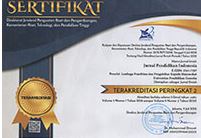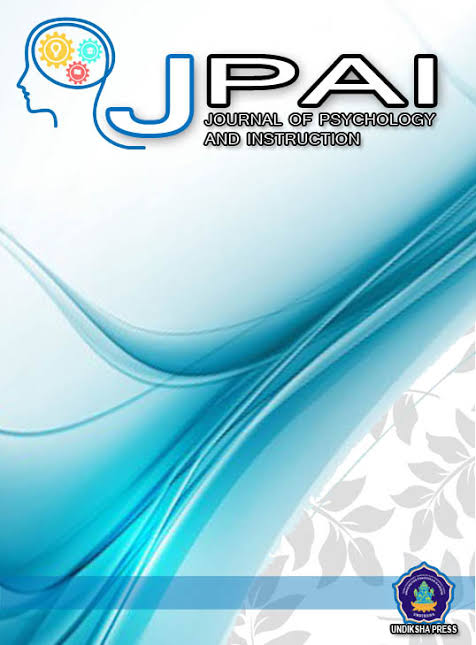Bumpy moments: A potential method to uncover teachers’ beliefs in the context of Indonesia education
DOI:
https://doi.org/10.23887/jpai.v4i3.33705Keywords:
Teachers’ belief, bumpy moments, educationAbstract
Teachers’ belief is an element that influences teachers’ decisions in their activities in the classroom. Researchers have formulated theories to conceptualize teachers’ knowledge and a fundamental belief in their teaching and developed methods to unpack them. ’Bumpy moments’ has been indicated as a potential method to uncover teachers’ belief in their natural setting. This study aims at developing an understanding of primary school teachers’ beliefs which underlie their decision in their classroom setting. The research used bumpy moments as a method. One primary school teacher who participated in this research were videotaped while she was teaching. The researchers and teacher watched their recorded teaching and the teacher was interviewed by using unstructured interview protocol. The research question was answered by running qualitative research to the primary school teacher. The research demonstrated that there are teacher beliefs held by the teacher. This can be seen in 1) beliefs in experience and ability in using media and methods in teaching, 2) beliefs in good teaching skills because understanding the students 'emotional dynamics in class and understanding the students' thought processes in learning, 3) beliefs in experiences in learning pedagogical knowledge in teaching. Bumpy moments methods were a potential method to be developed in Indonesian contexts.References
Blatt, M. M. (1969). The effects of classroom discussion programs upon children’s level of moral development. Unpublished doctoral dissertation. University of Chicago.
Blatt, M. M., & Kohlberg, L. (1975). The Effects of Classroom Moral Discussion upon Children’s Level of Moral Judgment. Journal of Moral Education, 4(2), 129–161. https://doi.org/10.1080/0305724750040207
Borg, M. (2001). Teachers’ beliefs. ELT Journal, 55(2), 186–188. https://doi.org/10.1093/elt/55.2.186
Borko, H., Eisenhart, M., Brown, C. A., Underhill, R. G., Jones, D., & Agard, P. C. (1992). Learning to Teach Hard Mathematics: Do Novice Teachers and Their Instructors Give up Too Easily? Journal for Research in Mathematics Education, 23(3), 194. https://doi.org/10.2307/749118
Brophy, J., & Good, T. L. (1986). Teacher behaviour and student achievement. Handbook of Research on Teaching, 328–375.
Calderhead, J., & Robson, M. (1991). Images of teaching: Student teachers’ early conceptions of classroom practice. Teaching and Teacher Education, 7(1), 1–8. https://doi.org/10.1016/0742-051X(91)90053-R
Carolyn, M., Theodora, W., A., & Indeks, T. (2013). Memahami perkembangan anak. Indeks.
Chong, S., Wong, I., & Lang, Q. C. (2004). Pre-service Teachers ’ Beliefs , Attitudes and Expectations : A Review of the Literature.
Creswell, J. W. (1994). Research design : qualitative & quantitative approaches (1st ed.). Thousand Oaks, Calif. : Sage Publications.
Djamba, Y. K., & Neuman, W. L. (2002). Social Research Methods: Qualitative and Quantitative Approaches. Teaching Sociology, 30(3), 380. https://doi.org/10.2307/3211488
Gettman, D. (2016). METODE PENGAJARAN MONTESSORI TINGKAT DASAR. Pustaka Pelajar.
Hidayat, M. (2017). Teacher’s beliefs and practices on assessment at SMAN 2 Salatiga in academic year 2016/2017 (A case study at SMAN 2 Salatiga) [Universitas Muhammadiyah Surakarta.]. http://eprints.ums.ac.id/48529/17/2. HALAMAN COVER.pdf
Kagan, D. M. (1992). Professional Growth among Preservice and Beginning Teachers. Review of Educational Research, 62(2), 129. https://doi.org/10.2307/1170578
Larenas, C. D., & Hernandez, Paola Alarcon Navarrete, M. O. (2015). A Case Study on EFL Teachers ’ Beliefs About the Teaching and Learning of English in Public. Porta Linguarium, 23, 171–186.
Blatt, M. M. (1969). The effects of classroom discussion programs upon children’s level of moral development. Unpublished doctoral dissertation. University of Chicago.
Blatt, M. M., & Kohlberg, L. (1975). The Effects of Classroom Moral Discussion upon Children’s Level of Moral Judgment. Journal of Moral Education, 4(2), 129–161. https://doi.org/10.1080/0305724750040207 DOI: https://doi.org/10.1080/0305724750040207
Borg, M. (2001). Teachers’ beliefs. ELT Journal, 55(2), 186–188. https://doi.org/10.1093/elt/55.2.186 DOI: https://doi.org/10.1093/elt/55.2.186
Borko, H., Eisenhart, M., Brown, C. A., Underhill, R. G., Jones, D., & Agard, P. C. (1992). Learning to Teach Hard Mathematics: Do Novice Teachers and Their Instructors Give up Too Easily? Journal for Research in Mathematics Education, 23(3), 194. https://doi.org/10.2307/749118 DOI: https://doi.org/10.2307/749118
Brophy, J., & Good, T. L. (1986). Teacher behaviour and student achievement. Handbook of Research on Teaching, 328–375.
Calderhead, J., & Robson, M. (1991). Images of teaching: Student teachers’ early conceptions of classroom practice. Teaching and Teacher Education, 7(1), 1–8. https://doi.org/10.1016/0742-051X(91)90053-R DOI: https://doi.org/10.1016/0742-051X(91)90053-R
Carolyn, M., Theodora, W., A., & Indeks, T. (2013). Memahami perkembangan anak. Indeks.
Chong, S., Wong, I., & Lang, Q. C. (2004). Pre-service Teachers ’ Beliefs , Attitudes and Expectations : A Review of the Literature.
Creswell, J. W. (1994). Research design : qualitative & quantitative approaches (1st ed.). Thousand Oaks, Calif. : Sage Publications.
Djamba, Y. K., & Neuman, W. L. (2002). Social Research Methods: Qualitative and Quantitative Approaches. Teaching Sociology, 30(3), 380. https://doi.org/10.2307/3211488 DOI: https://doi.org/10.2307/3211488
Gettman, D. (2016). METODE PENGAJARAN MONTESSORI TINGKAT DASAR. Pustaka Pelajar.
Hidayat, M. (2017). Teacher’s beliefs and practices on assessment at SMAN 2 Salatiga in academic year 2016/2017 (A case study at SMAN 2 Salatiga) [Universitas Muhammadiyah Surakarta.]. http://eprints.ums.ac.id/48529/17/2. HALAMAN COVER.pdf
Kagan, D. M. (1992). Professional Growth among Preservice and Beginning Teachers. Review of Educational Research, 62(2), 129. https://doi.org/10.2307/1170578 DOI: https://doi.org/10.3102/00346543062002129
Larenas, C. D., & Hernandez, Paola Alarcon Navarrete, M. O. (2015). A Case Study on EFL Teachers ’ Beliefs About the Teaching and Learning of English in Public. Porta Linguarium, 23, 171–186. DOI: https://doi.org/10.30827/Digibug.53765
Lind, G. (2006). Effective moral education: The Konstanz Method of Dilemma Discussion. Hellenic Journal of Psychology, 3(August), 189–196.
Montessori, M. (2004). The Discovery of the Child. Aakar Books.
Prawat, R. S. (1992). Teachers’ Beliefs about Teaching and Learning: A Constructivist Perspective. American Journal of Education, 100(3), 354–395. https://doi.org/10.1086/444021 DOI: https://doi.org/10.1086/444021
Romano, M. E. (2006). “Bumpy moments” in teaching: Reflections from practicing teachers. Teaching and Teacher Education, 22(8), 973–985. https://doi.org/10.1016/j.tate.2006.04.019 DOI: https://doi.org/10.1016/j.tate.2006.04.019
Ruane, J. M. (2005). Essentials of Research Methods: A Guide to Social Science Research. Blackwell Publishing.
Saomah, A. (2011). Implikasi Teori Belajar Terhadap Pendidikan Literasi. www.file.upi.edu/Direktori/FIP/JUR._PSIKOLOGI_PEND_DAN_BIMBINGAN/%0A196103171987032AAS_SAOMAH/IMPLEMENTASI_TEORI_BELAJAR_DAL%0AAM_PENDIDIKAN_LITERASI.pdf
Sardiman, A. (2010). Interaksi dan Motivasi Belajar Mengajar. PT. Raja Grafindo Persada.
Seidel, T., Stürmer, K., Blomberg, G., Kobarg, M., & Schwindt, K. (2011). Teacher learning from analysis of videotaped classroom situations: Does it make a difference whether teachers observe their own teaching or that of others? Teaching and Teacher Education, 27(2), 259–267. https://doi.org/10.1016/j.tate.2010.08.009 DOI: https://doi.org/10.1016/j.tate.2010.08.009
Shulman, L. (1987). Knowledge and Teaching:Foundations of the New Reform. Harvard Educational Review, 57(1), 1–23. https://doi.org/10.17763/haer.57.1.j463w79r56455411 DOI: https://doi.org/10.17763/haer.57.1.j463w79r56455411
Sutiarso, S. (2017). Teachers’ Belief Dalam Pembelajaran Matematika Dan Faktor Faktor Yang Mempengaruhinya. Jurnal Penelitian Dan Pembelajaran Matematika, 10(2). https://doi.org/10.30870/jppm.v10i2.1958 DOI: https://doi.org/10.30870/jppm.v10i2.1958
van Kan, C. A., Ponte, P., & Verloop, N. (2010). How to conduct research on the inherent moral significance of teaching: A phenomenological elaboration of the standard repertory grid application. Teaching and Teacher Education, 26(8), 1553–1562. https://doi.org/10.1016/j.tate.2010.06.007 DOI: https://doi.org/10.1016/j.tate.2010.06.007
Wang, M. C., Haertel, G. D., & Walberg, H. J. (1993). Toward a Knowledge Base for School Learning. Review of Educational Research, 63(3), 249–294. https://doi.org/10.3102/00346543063003249 DOI: https://doi.org/10.3102/00346543063003249
Winter, D. A., & Reed, N. (2015). The Wiley Handbook of Personal Construct Psychology. Wiley Blackwell. DOI: https://doi.org/10.1002/9781118508275










